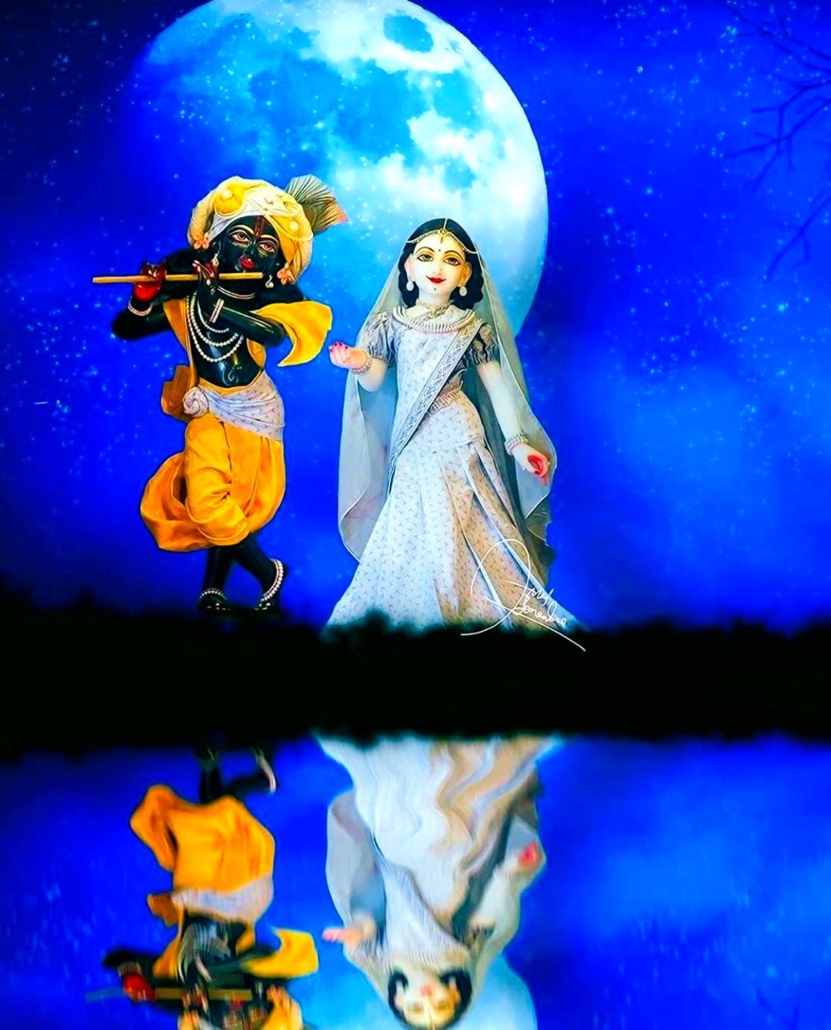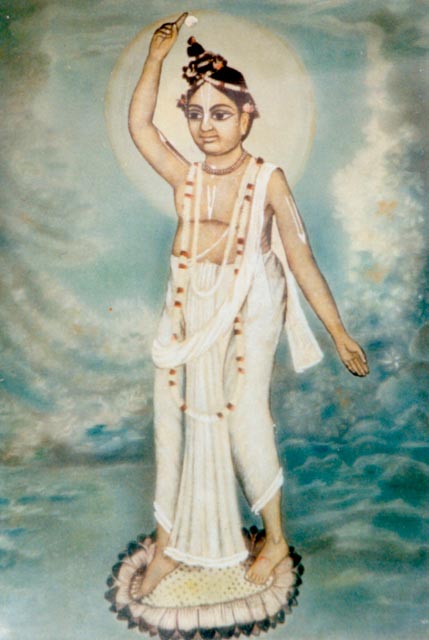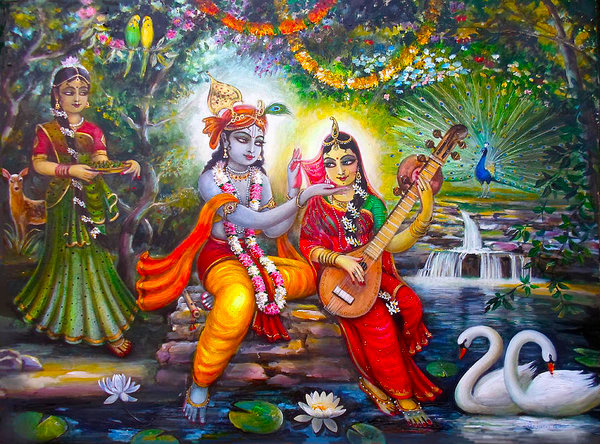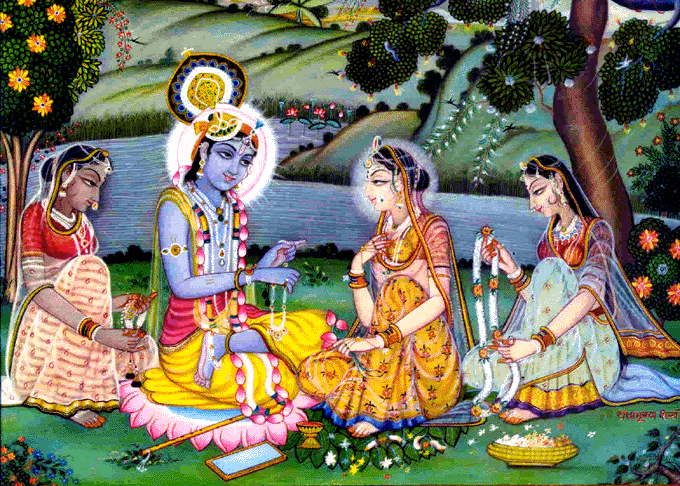Mahanidhi Madan Gopal Das
If you ask twenty different initiated Gaudiya Vaisnavas (aka Chaitanya Vaisnavas) to explain what is a Gaudiya Vaisnava; who is their worshipable ishta-devata; what is the goal of attainment (sadhya); and what is the practice (sadhana) or means to attain that goal—you will get TWENTY DIFFERENT ANSWERS!
Now we will cite the sacred scriptures to correctly answer these questions. First of all, who is Sri Chaitanya? Chaitanya Mahaprabhu is directly Bhagavan Sri Krishna, who, after immersing His heart in Srimati Radharani’s ecstatic loving emotions and covering Himself with Her supremely radiant golden color, appeared as Sri Chaitanya Mahaprabhu 500 years ago in Navadvipa Dhama, W. Bengal.
To put it simply, a Gaudiya Vaisnava is a Krishna devotee who follows the philosophy, teachings and the sadhana practices taught by Sri Chaitanya Mahaprabhu Himself, the sole founder of the Gaudiya Vaisnava Sampradaya.
Chaitanya Mahaprabhu’s personal words and exact teachings on the worshipable ishta-devata, the daily sadhana practices, and the spiritual goal i.e. sadhya are clearly presented in the books of the Gaudiya Vaisnava mahajana acharyas i.e. Six Goswamis, Sri Baladeva Vidyabhusana, Sri Narottama Dasa Thakura, and Srila Visvanatha Cakravarti.
So, if one is not following Sri Chaitanya’s teachings and practices to attain Mahaprabhu’s definition of spiritual perfection, he/she is not really a Gaudiya Vaisnava.
Here are Mahaprabhu’s personal instructions and answers to the opening questions.
In the beginning of Chaitanya-caritamrita, Sri Krishna Dasa Kaviraja presents the basis or foundation of Gaudiya Vaisnava dharma by quoting the direct words of Sri Chaitanya Mahaprabhu.
In one of His first teachings, Sri Krishna Chaitanya said, “I have come to this world to taste the essence of ecstatic Krishna prema and TO PREACH RAGANUGA-BHAKTI to the people [what to speak of the devotees!], prema-rasa-niryāsa, kariteāsvādana, rāga-mārga bhakti loke, karitepracāraṇa.” (Caitanya Caritamrita 1.4.15)
Sri Krishna Chaitanya said, “When My devotees hear about the immaculately pure love of the Vrajavasis, they will worship Me on the PATH OF RAGANUGA BHAKTI, and there by give up their duties within the varnashrama-system, vrajeranirmala raga, śunibhakta-gaṇa, rāga-mārgebhajeyena, chāḍi dharma-karma.” (Caitanya Caritamrita 1.4.33)
Chaitanya Mahaprabhu: “I relished the mellows of love in various ways. And through My pastimes I TAUGHT THE DEVOTEES HOW TO PRACTICE RAGANUGA-BHAKTI, prema-rasa āsvādila, vividhaprakāra, rāga-mārgebhakta bhakti, kare ye prakāre, tāhāśikhāilalīlā, ācaraṇadvāre.” (Caitanya Caritamrita 1.4.264-5)
Throughout Chaitanya-caritamrita, Mahaprabhu describes the Gaudiya sadhana of raganuga-bhakti (raga-marge)—both the physical practices and the internal mental practices of meditation on one’s siddha-deha and the eternal pastimes of Radha and Krishna.
Goal of Gaudiya Vaisnava
The essential teachings of Chaitanya Mahaprabhu’s Gaudiya Vaisnava dharma is fully described in just two chapters of Chaitanya-caritamrita (adi four, and madhya eight. Every Gaudiya Vaisnava should deeply study these two chapters. By this one will get a clear understanding of the actual true goal (sadhya) and proper means of attaining it (sadhana).
Chaitanya-caritamrita, madhyalila chapter eight is titled “Sri Ramananda Raya Samvad”. Here, Chaitanya Mahaprabhu, inspires and empowers His devotee Sri Ramananda Raya to answer His questions concerning Gaudiya Vaisnava sadhana and sadhya.
Chaitanya Mahaprabhu asked, “O Ramananda! WHAT IS THE GOAL OF LIFE, prabhukahepaḍaśloka, sādhyeranirṇaya?” (Caitanya Caritamrita 2.8.57)
Sri Ramananda Raya answered by describing many paths to God realization including varnashrama-dharma, karma-yoga, karmarpanam, niskama karma-yoga, jnana-misra bhakti, shuddha-bhakti, dasya-bhakti, sakhya-bhakti, vatsalya-bhakti, madhurya-bhakti, pure Vrajaprema, Srimati Radharani’s mahabhava, and lastly prema-vilasa-vivarta—the melting of Radha-Madhava’s hearts and identities in the union of ultimate divine love.
After listening to each of these paths and goals, Mahaprabhu would say, “This is not it, go further, go further.” When Sri Ramananda Raya described the Vrajasrngara-madhurya-bhava, and the love of Radha and Krishna relished in prema-vilasavivarta, Mahaprabhu confirmed, “YES! This is the topmost goal of life, prabhukahesādhyavastura, avadhieihaya.” (Caitanya Caritamrita 2.8.196)
Means to Attain the Goal
Mahaprabhu inquired, “But without practicing the proper sadhana, no one will attain this goal (sadhya). So please tell me the sadhana to attain this goal [i.e. Radha-Krishna premaseva in Vrindavana], sādhyavastusādhanavinu, kehanāhipāya, kṛpākari’ kaharāya, pābāraupāya?” (Caitanya Caritamrita 2.8.197)
Sri Ramananda Raya replied: “Those who develop the feelings and moods of the sakhis (sakhi/gopi-bhava) can attain the [Gaudiya Vaisnava] goal of life, Radha-Krishna’s seva in the beautiful bowers of Vrindavana. THERE IS NO OTHER WAY TO REACH THIS GOAL.”
sakhīvināeilīlāya, anyeranāhigati//sakhī-bhāve ye tāṅre, kareanugati
rādhākṛṣṇakuñjasevā, sādhyaseipāya//seisādhyapāiteāra, nāhikaupāya
Qualification to Start Raganuga Bhakti
Sri Ramananda Raya: “A Gaudiya Vaisnava who has “divine” greed to attain the gopīs’ nectareanprema (gopibhava amrita) will abandon the rites and rituals of the social/spiritual system i.e. varṇāśrama, and disregard the opinions or prohibitions of others to worship Krishna on the path of raganuga-bhakti, seigopī-bhāvāmṛte, yāṅralobhahaya, veda dharma lokatyaji, se kṛṣṇebhajaya.” (Caitanya Caritamrita 2.8.220)
Attaining Sri Krishna: Vraja or Vaikuntha?
Sri Ramananda Raya: “One who practices raganugabhajana will attain Vrajendranandana Sri Krishna in Vraja, rāgānuga-mārgetāṅre, bhajeyeijana, sei-janapāyavraje, vrajendra-nandana. (Caitanya Caritamrita 2.8.221)
“One, who follows the path of raganuga-bhakti, after accepting the gopi-bhava of one of Sri Krishna’s eternal associates in Vrindavana, will get a spiritual body (siddha deha), and the appropriate bhava and qualification to attain Sri Krishna in Vraja, vraja-lokerakonabhāva, lañāyeibhaje, bhāva-yogyadehapāñā, kṛṣṇapāyavraje.” (Caitanya Caritamrita 2.8.222)
Then Sri Ramananda Raya explains the importance of accepting/following the mood and feeling of a Vrajagopi like Sri Rupa or Tulasi manjari. By doing this the raganuga sadhaka will attain an eternal siddha deha in Vrindavana.
Sri Ramananda Raya: “If one follows the mood and bhava of a gopi, one will attain the spiritual body of a gopi, seibhāveanugati, gopī-deha-prāpti.” (Caitanya Caritamrita 2.8.225)
But then Sri Ramananda Raya gives a stern warning (verses 226, 230) that Gaudiya Vaisnava sadhakas WILL NEVER ATTAIN KRISHNA in Vrindavana without practicing raganuga-bhakti.
Sri Ramananda Raya: “One who just follows the path of vaidhi-sadhana will never attain Krishna’s association, taste the nectar of His lotus feet, nor attain Krishnachandra in Vraja, aṅghripadmasudhāyakahe, krishnasaṅgānanda, vidhimārgenāpāiye, vrajekrishna-candra.” (Caitanya Caritamrita 2.8.226)
The Gaudiya Vaisnava Sadhana & Sadhya
Sri Ramananda Raya concludes his teachings by presenting Sri Chaitanya Mahaprabhu’s essential instructions about the actual goal and path of practice for all Gaudiya Vaisnavas. This particular type of sadhana and sadhya is the unique gift to humanity by the Krishna Prema Avatara Chaitanya Mahaprabhu, which He only gives every 310 billion years or so!
Sri Ramananda Raya: “Listen, O Gaudiya Vaisnavas! You all must accept gopi-bhava, and day and night think about Radha-Krishna’s pastimes while mentally serving the Divine Couple in your siddha deha. By practicing raganuga-bhakti like this, you will definitely attain sakhi/gopi-bhava and the lotus feet of Radha-Krishna.” (Caitanya Caritamrita 2.6.228-229)
ataevagopī-bhāva, kariaṅgīkāra, rātri-dinacinterādhā, kṛṣṇeravihāra
siddha-dehecintikare, tāhāṅñisevana, sakhī-bhāvepāyarādhā, kṛṣṇeracaraṇa
After hearing Sri Ramananda Raya’s clear and exact explanations about His own teachings, Chaitanya Mahaprabhu was extremely pleased and happy, so He warmly embraced Ramananda as they cried together in ecstatic Krishna prema, eta suniprabhutāṅre, kailaāliṅgana, dui janegalāgali, karenakrandana. (Caitanya Caritamrita 2.8.233)
Later in madhya-lila, Chaitanya Mahaprabhu Himself gave the same instructions on raganuga-bhakti sadhana and sadhya to Sri Rupa Gosvami and Sri Sanatana Goswami. Mahaprabhu empowered the divine brothers, and ordered them to describe the details of raganuga-bhakti in their books for the benefit of all Gaudiya Vaisnavas.
Sri Chaitanya Mahaprabhu said, “O Sanatana Gosvami! There are two types of sādhana in rāgānugā-bhakti: external and internal. In the external sādhaka body, the devotee performs śravaṇa and kīrtana. Internally, within the mind, one should meditate on one’s own siddha-deha and mentally serve Sri Krishna day and night in Vraja.” (Caitanya Caritamrita 2.22.156-157):
bāhyaantaraihāra, dui ta’ sādhana, bāhyesādhakadehekare, śravaṇa-kīrtana
manenija-siddha-deha, kariyābhāvana, rātri-dine karevraje, krishnerasevana
So…Who is a Gaudiya Vaisnava? It is a devotee who knows and follows the personal teachings of Sri Chaitanya Mahaprabhu, the founder of Gaudiya Vaisnava dharma, regarding the goal and means of attainment.
By reading this post, we hope all our devoted friends will now have a clear understanding about what is the Gaudiya Vaisnava siddhanta regarding the actual sadhana and sadhya needed to attain the goal of our precious human forms of life.
May all find the true path, follow it, and attain the eternal prema-seva of Sri Sri Radha Govinda Yugala in the groves of Vrindavana.
Raganuga-bhakti ki jai! Radha-Krishna nitya-sevaki jai! Jaya Jaya Sri Radhe!
You may also like related articles:
GAUDIYA VAISNAVA, IDENTITY AND GOAL




